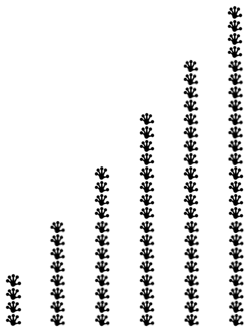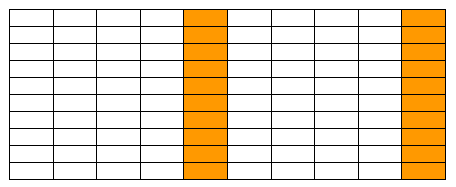In this unit of work we link the development of skip-counting patterns to bars on a relationship graph. We also plot our skip-counting patterns on a hundreds board.
- Continue a skip-counting pattern.
- Describe skip-counting patterns.
- Use graphs to illustrate skip-counting patterns.
In this unit we look at skip-counting patterns. These are patterns obtained by adding the same, constant, number to make the next number every time. So the difference between any two terms in a skip-counting pattern is the same. This is a good exercise to help reinforce the various concepts relating to pattern. In particular, it helps us to understand the idea of a recurrence relation between consecutive terms.
Skip-counting patterns are also called arithmetic progressions. In secondary school, expressions for both the general term of an arithmetic progression and the sum of all of the numbers in the progression are found.
The learning opportunities in this unit can be differentiated by providing or removing support to students and by varying the task requirements. Ways to differentiate the tasks include:
- varying the difficulty of the skip. For example, reduce the complexity by using skips of 2, 5 or 10. Increase the complexity by using odd numbers or numbers larger than 5
- increasing the difficulty by asking the students to extend the number of skips in the pattern. For example, in the Exploring part of the unit ask the students to extend the pattern to 10 or more skips
- using a variety of materials to represent the skips. For example, multilink cubes joined in groups of 3.
The contexts for the skip patterns used in this unit can be adapted to suit the interests and experiences of your students. For example in the Exploring part of the unit:
- involving the students in finding or suggesting the skip counting images related to their interests or culture
- using images of spiders, for example katipō (8 legs), lizards or frogs (4 legs) and butterflies (2 wings), particularly those that are native to New Zealand
- using images of animals, plants and insects that are found in the local area. For example tuatara, kōwh ai, tūī, wētā
- using skip counting in te reo Māori, and the home languages of your students.
- Counters
- Cubes
- Squared paper for graphing
- Pictures of objects for exploration
Getting Started
Explain that today we will explore the pattern of 4s by counting the number of feet on geckos. We then use this information to build a relationship graph.
- Ask: How many feet does a gecko have?
- Share ideas. Hopefully someone will know that a gecko is a type of lizard, and has four feet. Show students a picture of a gecko.
- Using counters begin to develop a chart of the number of feet to the number of geckos.

- Ask: How many feet are there on 2 geckos?
How did you work that out? - It is useful for the students to listen to the strategies that others use. More advanced Level 1 students will be able to count on from 4 to find the answer and many may have 4 + 4 as a known fact.
- Repeat the process with 3 and 4 geckos. Each time continue to add the information to the chart.
- Ask the students to work out how many feet there would be on 6 geckos. If some of the students find the answer quickly, ask them to find the answer using another strategy.
- Share solutions. These may include:
- skip-counting with or without the calculator
- counting on using a number line or hundreds board
- using counters to find 6 groups of 4.
- Ask the class to complete the chart with up to 6 geckos.

- Ask: What can you tell me about this chart?
Share ideas. Encourage the students to focus on the relationship between the number of geckos and the number of feet. - Ask the students how they could record this information using grid paper.
Exploring
Over the next 2-3 days, the students work in pairs to explore the number patterns of other skip-counts. At the end of each session the students share their charts with the rest of the class.
- Place pictures of items that the students are to investigate in a “hat”. Ask each pair to draw one out and then investigate the pattern up to at least 6. Encourage students to extend the pattern beyond 6.
- Pictures could include:
- tricycles (3 wheels)
- bicycles (2 wheels)
- hands (5 fingers)
- spiders (8 legs)
- glasses (2 lenses)
- frog (4 legs)
- kiwi (2 legs)
- stools (3 legs)
- Remind the students that they are to record their explorations on paper or digitally.
- At the end of each session share and discuss charts and number patterns. Ask the students to identify the patterns that are the same.
Reflecting
In today’s session we use calculators to extend our skip-counting into the hundreds. We record our patterns on a hundreds chart.
- As a class look at the chart to show hands (5 fingers). Skip count together in 5s, shading the counts on a hundreds chart.

- As the chart is shaded, ask questions which encourage the students to look for patterns in the numbers as they make their predictions.
Which number will be next?
How do you know? - Give the students (in pairs) a hundred’s chart and ask them to shade in one of the skip counting patterns that they had charted on the previous days.
- Display, share and discuss at the end of the session.
Dear parents and whānau,
This week in maths we have been looking at skip-counting patterns and the charts that can be made from them.
Your child will be able to explain to you exactly what we did in class. Here is a chart made from a skip-counting pattern. Talk with your child about what the next number in the pattern will be. Put that number onto the chart. Discuss with your child how the pattern would continue.

Try to think of how that pattern might describe something in your whānau. Could you make a similar chart of another number pattern related to nature, sport, or another family interest.
This is an important part of maths. Thank you for your help.